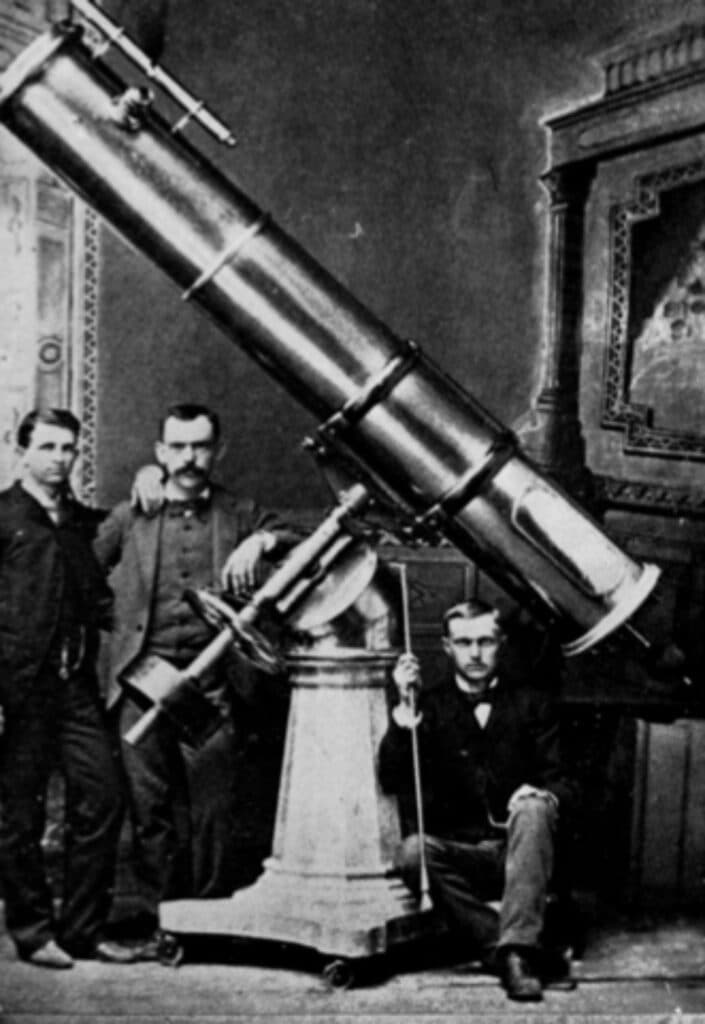Observatories at WC Date Back to Late 1800s
A tradition that predates Homecoming, intercollegiate athletics and Greek Life at Wilmington College began fewer than a dozen years after the College’s founding in 1870 when students raised $200 for WC’s first telescope.
PICTURED: In 1882, students Reynold Jenney and Milton Farquhar raised funds to purchase or have fabricated the parts for a 12-inch reflecting telescope with the assistance and encouragement of their mathematics professor, Levi T. Edwards. All three are believed to pictured sometime between 1882 and 1984, the period during which the telescope was housed in Teacher Ellen Wright’s Latin classroom.
It was essentially a homemade instrument that served the College well until the mid-20th century, when a new 16-inch reflector telescope was installed on the roof of Kettering Science Center in 1966.
Fast-forward a half century to 2016, when a new observatory was the cherry on the sundae that is the Center for the Sciences and Agriculture. It too features a 16-inch mirror but gone is the required trek up the steps of the cold observatory on clear winter nights to, one-by-one, look into the eyepiece for viewing the heavens. Rather, students can view Venus and Mars projected on a large screen in their classroom or from computers literally anywhere on Earth.
The newest observatory not only has an academic rationale. It also gives a nod to tradition.
Indeed, in 1882, students Reynold Janney and Milton Farquhar raised funds to purchase or have fabricated the parts of a telescope. With the assistance and encouragement of their mathematics professor, Levi T. Edwards, they purchased a 12-inch reflecting lens before having the local Farquhar Furnace Company craft the telescope’s brass barrel and all the hardware that held it together. Champion Bridge fashioned the huge pedestal on a lathe.
The College initially stored the telescope in "Teacher" Ellen C. Wright’s Latin classroom for ease of maneuvering outside for viewing. After two years, in 1884, the telescope was housed in a wooden observatory structure in what then was the middle of campus on the current site of the Simon Goodman Memorial Carillon.
A more permanent, brick structure for the observatory was erected in 1892 on the same location, where it served students until it was razed in 1958 to make way for the Carillon tower. The College placed the telescope observatory a top of Kettering Science Hall several years later.
Dr. Oscar F. Boyd, a beloved chemistry professor and WC mainstay for 56 years, wrote in his 1961 history of Wilmington College that, while he was a student, from 1909 to 1912, the College required all degree-seekers take a course in astronomy.
Two other former Wilmington College students also thrived under that stipulation and play significant roles with regard to the original telescope.
Dr. Joseph Haines Moore Jr. was an 1897 WC graduate who went on to earn a Ph.D. from Johns Hopkins University. The College’s makeshift telescope fascinated Moore and served to inspire him as he became one of the world’s foremost authorities in astronomy and director at the Lick Observatory on Mt. Hamilton in California. He is famous for work on the nation’s radial velocity program and for leading an astronomical expedition to Chile from 1909 to 1913.
The other is Frank A. Tener, a 1922 graduate with a Bachelor of Science degree in education with majors in mathematics and astronomy — and a founding member of Sigma Zeta fraternity in 1916. Tener was a teacher and administrator in the public school system before entering the business world and later joining the College’s science faculty as an instructor in astronomy and mathematics in the 1950s and ‘60s.
A longtime member of the Wilmington Astronomy Club, which was especially active in the 1930s and ‘40s, he took it upon himself to lead the renovation of the observatory in the mid-1950s. After 73 years of use, many of the telescope’s components required refurbishing. He oversaw the instrument’s overhaul and remounting, and helped tidy the observatory, the walls of which were covered in scribbles and “Kilroy was here” -like graffiti from generations of users.
The most notable was the exclamation, “We saw Halley’s Comet in 1910.”
Wilmington News Journal reporter Alan Connor wrote at the observatory’s ensuing rededication in 1955 that, “This is just a part of the story of the Wilmington telescope, a telescope that is more than a telescope; a product of loving hands of Wilmington people whose hearts and minds were filled with awe at the wonders of the heavens.”
Once the observatory was installed a top Kettering, it wasn’t long before the College purchased a new telescope in 1966. Tener was present when the 16-inch Newtonian-Cassegrainian reflector telescope replaced the then 84-year-old model built by students.
Emeritus professor of physics, Dr. Esmail Hejazifar, a faculty member from 1985 to 2017 taught courses in solar and stellar astronomy. He recalled opening the former Kettering observatory to those interested in viewing the brilliant Hale-Bopp Comet in 1997. No doubt, students will be viewing fascinating astronomical phenomena before Halley’s Comet returns in 2061 or Hale-Bopp’s next visit to the inner solar system in 4385.
This is the latest story in the series of "Sesquicentennial Moments" featured during the College's milestone 150th anniversary, which is being celebrated through spring 2021.
